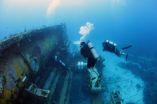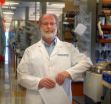(Press-News.org) A team of researchers from the Georgia Institute of Technology is using the Aquarius underwater laboratory off the coast of Florida to study how the diversity of seaweed-eating fish affects endangered coral reefs. The research mission, which began Sept. 13, may provide new information to help scientists protect and even restore damaged coral reefs in the Caribbean.
Led by Mark Hay, a Georgia Tech professor of biology, the 10-day mission includes two Ph.D. students and a postdoctoral researcher who are living 50 feet below the surface in the unique underwater lab. Aquarius, which is about the size of a school bus, includes scientific laboratories and living quarters for up to six scientists who can live and work underwater for the entire length of the mission.
Hay's research team has been studying how seaweeds and fish affect the health of coral reefs in the Pacific Ocean and Caribbean Sea. They have shown that the natural defenses of seaweeds can harm the coral, and that plant-eating fish can control the growth of the noxious seaweed. The new studies will build on that knowledge and provide new information on the complex factors affecting reef ecosystems.
"Consumption of seaweeds plays a critical role in structuring coral reefs and in selecting for algal traits that deter herbivorous fish," Hay explained. "Recent studies have noted dramatic variance among species in the susceptibility of herbivorous fish to seaweed chemical and structural defenses. These differences can translate into dramatic direct effects of herbivore diversity on seaweeds."
Because certain fish species eat specific seaweed species, and certain seaweeds are more damaging to coral than others, differences in the diversity of seaweed-eating fish can have a dramatic indirect effect on corals – as well as on changes in the structure and function of the endangered reefs.
"Our mission to Aquarius will allow us to study experimentally how herbivore diversity may be managed to conserve and even restore reefs," Hay added. "In previous studies, we have demonstrated that herbivore diversity affected the function and structure of the coral reefs. We plan to build on that research in this new study through Aquarius."
During the 10-day mission, the researchers will evaluate changes in reef communities near Aquarius, where they have built large cages and enclosed different species of fish for the past ten months. Within the enclosures, they included specific species of fish, or mixes of different species. They will be evaluating the effects of these different fish and mixes of fish on the health and growth of the coral to determine:
The long-term effects of the fish on the community structure;
Which seaweeds are most damaging to corals and which herbivores can best control these species;
How small mobile species and recruiting juvenile fish that can pass through the cage mesh respond to community changes;
How algal chemical and mineral defenses generate the mechanisms driving these changes.
Field studies by Hay's group have previously shown that several common species of seaweeds in both the Pacific and Caribbean can kill corals upon contact using chemical means. While competition between seaweed and coral is just one of many factors affecting the decline of coral reefs worldwide, this chemical threat may provide a serious setback to efforts aimed at repopulating damaged reefs.
Seaweeds are normally kept in check by herbivorous fish, but in many areas overfishing has reduced the populations of these plant-consumers, allowing seaweeds to overpopulate coral reefs.
Other studies done by the group using a similar type of reef enclosure found that mixing two specific species of herbivorous fishes decreased seaweed cover by as much as 76
percent, increased coralline crusts that stimulate coral settlement by as much as 117 percent, increased coral growth by 22 percent, and prevented additional coral loss.
The new study will assess the impact of different species of seaweed-eating fish and compare those to previous results evaluating different mixes of fish. The goal will be to determine which specific mixes of fish can control the most damaging of seaweeds and to evaluate the importance of herbivore diversity in suppressing seaweeds and protecting corals. This information could be used to help manage fishing practices to protect the reefs.
"The particular biodiversity of herbivores may be as important as the density, or mass, of herbivores in determining the structure, function, and health of reef communities," Hay said. "We know too little of the species-specific effects of reef herbivores, how effects of multiple species sum to produce an overall effect, or which particular mix of herbivores is critical for suppressing aggressive seaweeds to maintain reef function."
Coral reefs are declining worldwide, and scientists studying the problem had suspected that proliferation of seaweed was part of the cause – perhaps by crowding out the coral or by damaging it physically.
By allowing scientists to remain on the ocean floor for long periods of time – a capability known as saturation diving – Aquarius helps researchers get more work done by extending the dive time at depth and eliminating the decompression time that would be required for returning to the surface each day. Owned by the National Oceanic and Atmospheric Administration, Aquarius is managed by the University of North Carolina Wilmington and located in the Florida Keys National Marine Sanctuary.
INFORMATION:
Study in underwater laboratory may help manage seaweed-eating fish that protect coral
2011-09-19
ELSE PRESS RELEASES FROM THIS DATE:
Lack of protein FKBP51 in old mice improves resilience to depressive behavior
2011-09-19
Tampa, FL (Sept. 15, 2011) -- Decreasing expression of a protein associated with susceptibility to depression made old mice resistant to depressive-like behavior while improving their hormonal response to stress, a study led by researchers at the University of South Florida found. The lack of this protein, FKBP51, did not adversely affect their memory, learning, or basic motor functions.
The study suggests that drug discovery efforts aimed at reducing levels of the protein FKBP51 may yield new antidepressant therapies. The findings appear online today (Sept. 15, 2011) ...
Space Expanding, Multi-Tasking And Very Stylish Plan 3 Highlights Pardee's LivingSmart Homes At Fair Oaks Ranch
2011-09-19
Pardee Homes is an award-winning builder bringing award-winning homes to Southern California homebuyers, most recently with its new LivingSmart Homes at Fair Oaks Ranch in the Santa Clarita Valley. Finalist in the 2011 SoCal Awards as Green Community/Suburban, the homes feature a standout level of green measures, including solar power systems as a standard.
Prices begin in the $400,000s at LivingSmart Homes, for plan sizes that range from approximately 1,846 to 2,432 square feet of living space. The design series includes 4 floor plans, each with a two-bay garage.
"Of ...
Genetics may predict why calcium increases risk for prostate cancer
2011-09-19
A study led by University of Southern California (USC) epidemiologists suggests that a high intake of calcium causes prostate cancer among African-American men who are genetically good absorbers of the mineral.
"High dietary intake of calcium has long been linked to prostate cancer and this study suggests that these associations are likely to be causal," said Sue Ann Ingles, Dr.P.H., associate professor of preventive medicine at the Keck School of Medicine of USC and principal investigator of the study. "At this point, however, we're not in a position to make any public ...
Moms who eat high-fat diet before, during pregnancy 'program' babies to be fat, at risk
2011-09-19
PORTLAND, Ore. — New research in mice indicates that babies born to moms who eat a high-fat diet before and during pregnancy have a higher fat mass and smaller livers than babies whose moms consume low-fat fare, according to scientists at Oregon Health & Science University Doernbecher Children's Hospital.
The good news, the researchers report, is that moms who switch to a low-fat diet during pregnancy considerably reduce the risk of these negative effects. Their findings are published online in the American Journal of Physiology and Endocrinology Metabolism, a publication ...
Children with autism and gastrointestinal symptoms have altered digestive genes
2011-09-19
Researchers at the Center for Infection and Immunity (CII) at Columbia University's Mailman School of Public Health and at the Harvard Medical School report that children with autism and gastrointestinal disturbances have altered expression of genes involved in digestion. These variations may contribute to changes in the types of bacteria in their intestines.
Full study findings are reported online in the journal PLoS ONE.
Autism, which is defined by impairments in verbal and non-verbal communication, social interactions, and repetitive and stereotyped behaviors, affects ...
Congressional briefing sheds light on poor seniors' employment struggles
2011-09-19
An expert panel speaking on Capitol Hill today demonstrated that the Great Recession has had a disproportionately negative impact on low-income older workers, although programs such as the federal Senior Community Service Employment Program (SCSEP) have managed to provide some valuable benefits to this disadvantaged demographic group.
The congressional briefing — held on the eve of National Employ Older Workers Week — was titled, "Older Workers: Multiple Returns on Our Public Investment." It was sponsored by The Gerontological Society of America (GSA) and the American ...
Temperature controls the genetic message
2011-09-19
A team of scientists at the CSIC has shown that temperature can play a critical role in the control of splicing. The team led by Josep Vilardell, ICREA scientist at the CSIC's Molecular Biology Institute of Barcelona, has demonstrated that temperature, through its effects on RNA structure, can control how the genetic information will be processed. The results of this work are published this week in Molecular Cell.
Hiding intronic cues
For some time, scientists have been trying to understand how the spliceosome -the molecular 'machine' responsible for splicing- works ...
Newest cancer therapies multi-task to eliminate tumors
2011-09-19
AUGUSTA, Ga. – Some of the newest therapies in the war on cancer remove the brakes cancer puts on the immune system, Georgia Health Sciences University researchers report.
These immunotherapies, such as CTLA4, strengthen the immune system's attack on cancer by keeping apart two proteins that prevent key immune cells called T cells from activating.
Research featured on the cover of the Journal of Immunology suggests that these therapies also keep tumors from benefitting from IDO, an enzyme used by fetuses and tumors alike to suppress the immune response.
"This is ...
New threat closes in on iconic Galápagos wildlife
2011-09-19
Renewed vigilance over the biosecurity of the Galápagos Islands is needed, based on new research on the risk posed by West Nile virus.
Scientists from the Zoological Society of London (ZSL), the University of Leeds and the New York State Department of Health, together with the Galápagos National Park Service and University of Guayaquil, have been studying the disease threat posed by Islands' mosquito populations. They have discovered that a species of these biting insects is capable of transmitting West Nile virus, a potentially dangerous disease for the archipelago's ...
Quantum behavior with a flash
2011-09-19
This press release is available in German.
Just as a camera flash illuminates unseen objects hidden in darkness, a sequence of laser pulses can be used to study the elusive quantum behavior of a large "macroscopic" object. This method provides a novel tool of unprecedented performance for current experiments that push the boundaries of the quantum world to larger and larger scales. A collaboration of scientists led by researchers from the Vienna Center for Quantum Science and Technology (VCQ) at the University of Vienna report this new scheme in the forthcoming ...



